Term Paper: Negative Effects of Corrective Feedback in L2 Writing
VerifiedAdded on 2023/06/04
|14
|3822
|68
Literature Review
AI Summary
This literature review examines the negative impacts of corrective feedback on second language (L2) writing, particularly in EFL/ESL settings. It highlights gaps in current corrective feedback mechanisms, noting that traditional error feedback often fails to meet the needs of modern language learners. The review identifies issues such as the lack of rhetorical competence development, the absence of subjective consideration for individual student needs, and discrepancies between automated writing evaluation systems and teacher feedback. It contrasts the effects of direct and indirect corrective feedback, arguing that direct feedback can become repetitive and may not encourage independent learning, while indirect feedback, though potentially more effective, can be confusing due to reliance on symbols. Ultimately, the review suggests that current feedback methods can hinder the development of strong writing skills in L2 learners, calling for more tailored and effective approaches. The document is contributed by a student and available on Desklib, a platform offering study tools and resources for students.
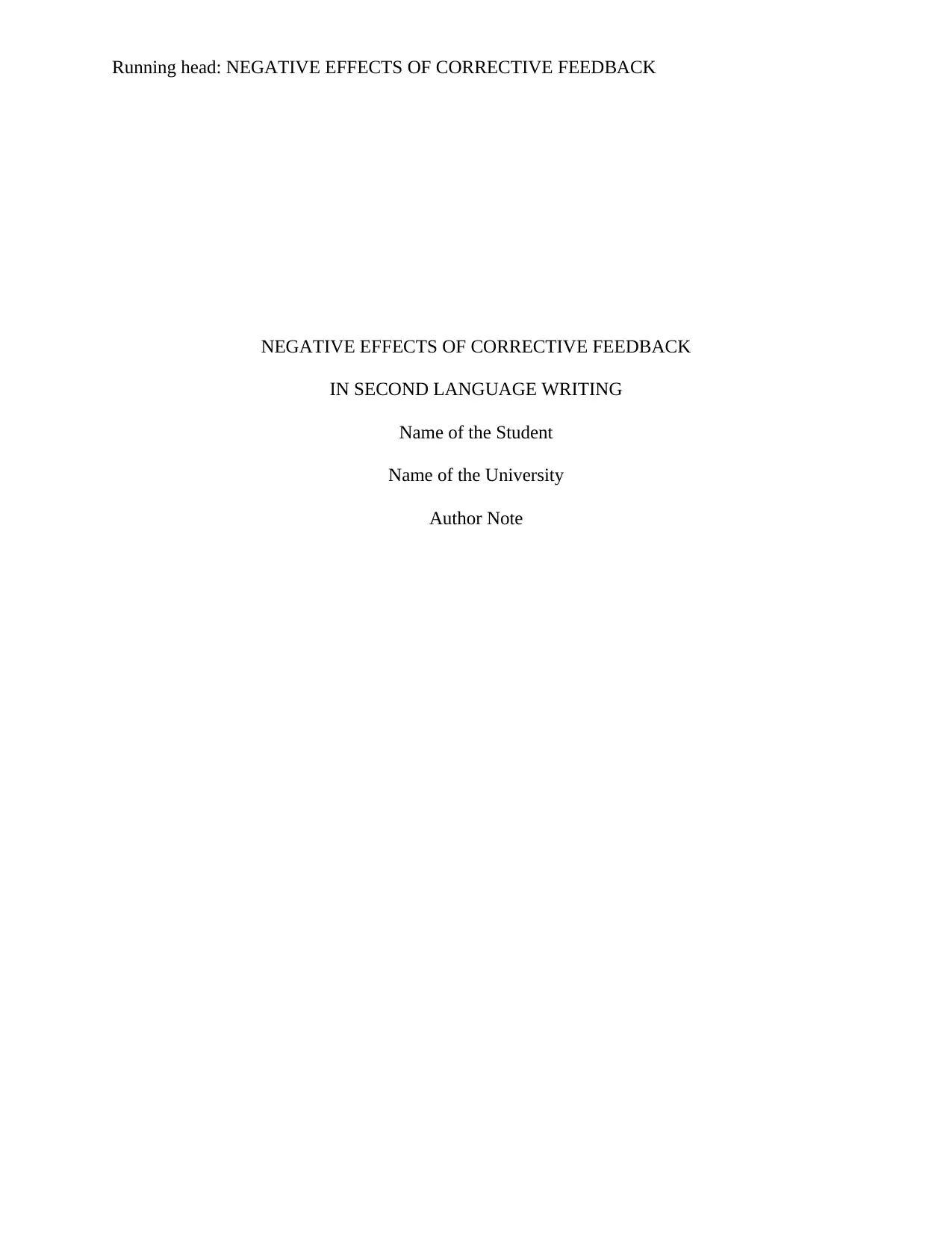
Running head: NEGATIVE EFFECTS OF CORRECTIVE FEEDBACK
NEGATIVE EFFECTS OF CORRECTIVE FEEDBACK
IN SECOND LANGUAGE WRITING
Name of the Student
Name of the University
Author Note
NEGATIVE EFFECTS OF CORRECTIVE FEEDBACK
IN SECOND LANGUAGE WRITING
Name of the Student
Name of the University
Author Note
Paraphrase This Document
Need a fresh take? Get an instant paraphrase of this document with our AI Paraphraser
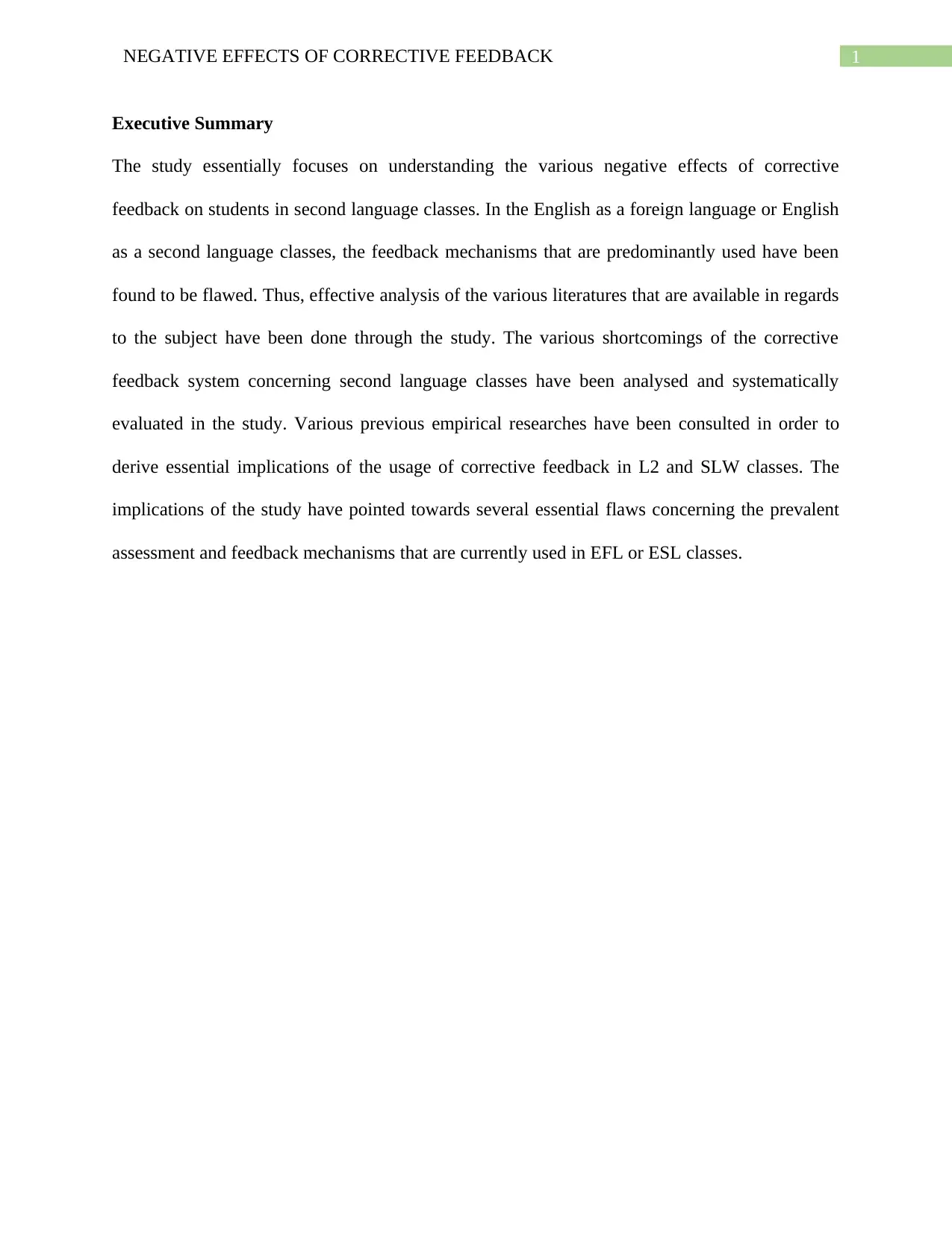
1NEGATIVE EFFECTS OF CORRECTIVE FEEDBACK
Executive Summary
The study essentially focuses on understanding the various negative effects of corrective
feedback on students in second language classes. In the English as a foreign language or English
as a second language classes, the feedback mechanisms that are predominantly used have been
found to be flawed. Thus, effective analysis of the various literatures that are available in regards
to the subject have been done through the study. The various shortcomings of the corrective
feedback system concerning second language classes have been analysed and systematically
evaluated in the study. Various previous empirical researches have been consulted in order to
derive essential implications of the usage of corrective feedback in L2 and SLW classes. The
implications of the study have pointed towards several essential flaws concerning the prevalent
assessment and feedback mechanisms that are currently used in EFL or ESL classes.
Executive Summary
The study essentially focuses on understanding the various negative effects of corrective
feedback on students in second language classes. In the English as a foreign language or English
as a second language classes, the feedback mechanisms that are predominantly used have been
found to be flawed. Thus, effective analysis of the various literatures that are available in regards
to the subject have been done through the study. The various shortcomings of the corrective
feedback system concerning second language classes have been analysed and systematically
evaluated in the study. Various previous empirical researches have been consulted in order to
derive essential implications of the usage of corrective feedback in L2 and SLW classes. The
implications of the study have pointed towards several essential flaws concerning the prevalent
assessment and feedback mechanisms that are currently used in EFL or ESL classes.
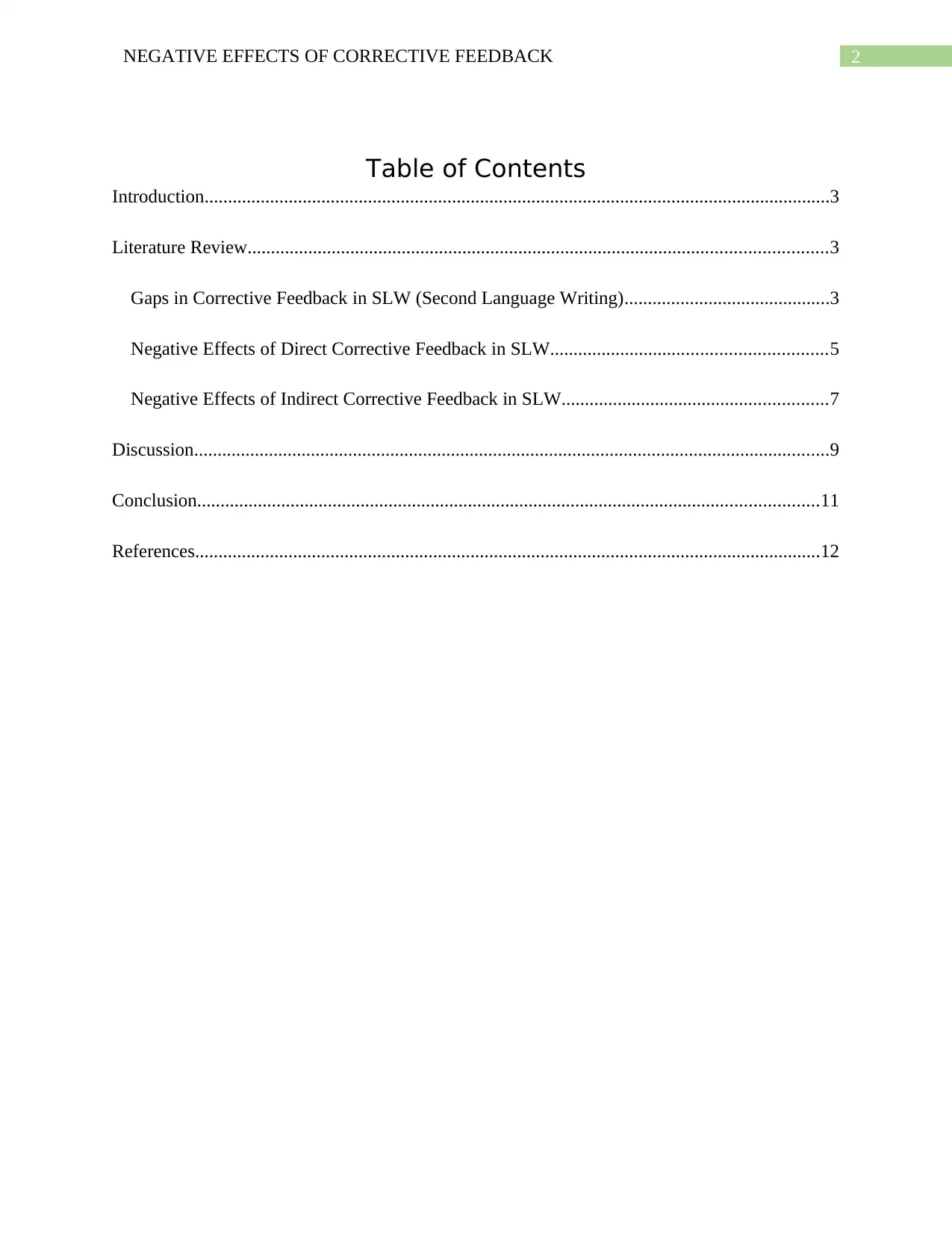
2NEGATIVE EFFECTS OF CORRECTIVE FEEDBACK
Table of Contents
Introduction......................................................................................................................................3
Literature Review............................................................................................................................3
Gaps in Corrective Feedback in SLW (Second Language Writing)............................................3
Negative Effects of Direct Corrective Feedback in SLW...........................................................5
Negative Effects of Indirect Corrective Feedback in SLW.........................................................7
Discussion........................................................................................................................................9
Conclusion.....................................................................................................................................11
References......................................................................................................................................12
Table of Contents
Introduction......................................................................................................................................3
Literature Review............................................................................................................................3
Gaps in Corrective Feedback in SLW (Second Language Writing)............................................3
Negative Effects of Direct Corrective Feedback in SLW...........................................................5
Negative Effects of Indirect Corrective Feedback in SLW.........................................................7
Discussion........................................................................................................................................9
Conclusion.....................................................................................................................................11
References......................................................................................................................................12
⊘ This is a preview!⊘
Do you want full access?
Subscribe today to unlock all pages.

Trusted by 1+ million students worldwide
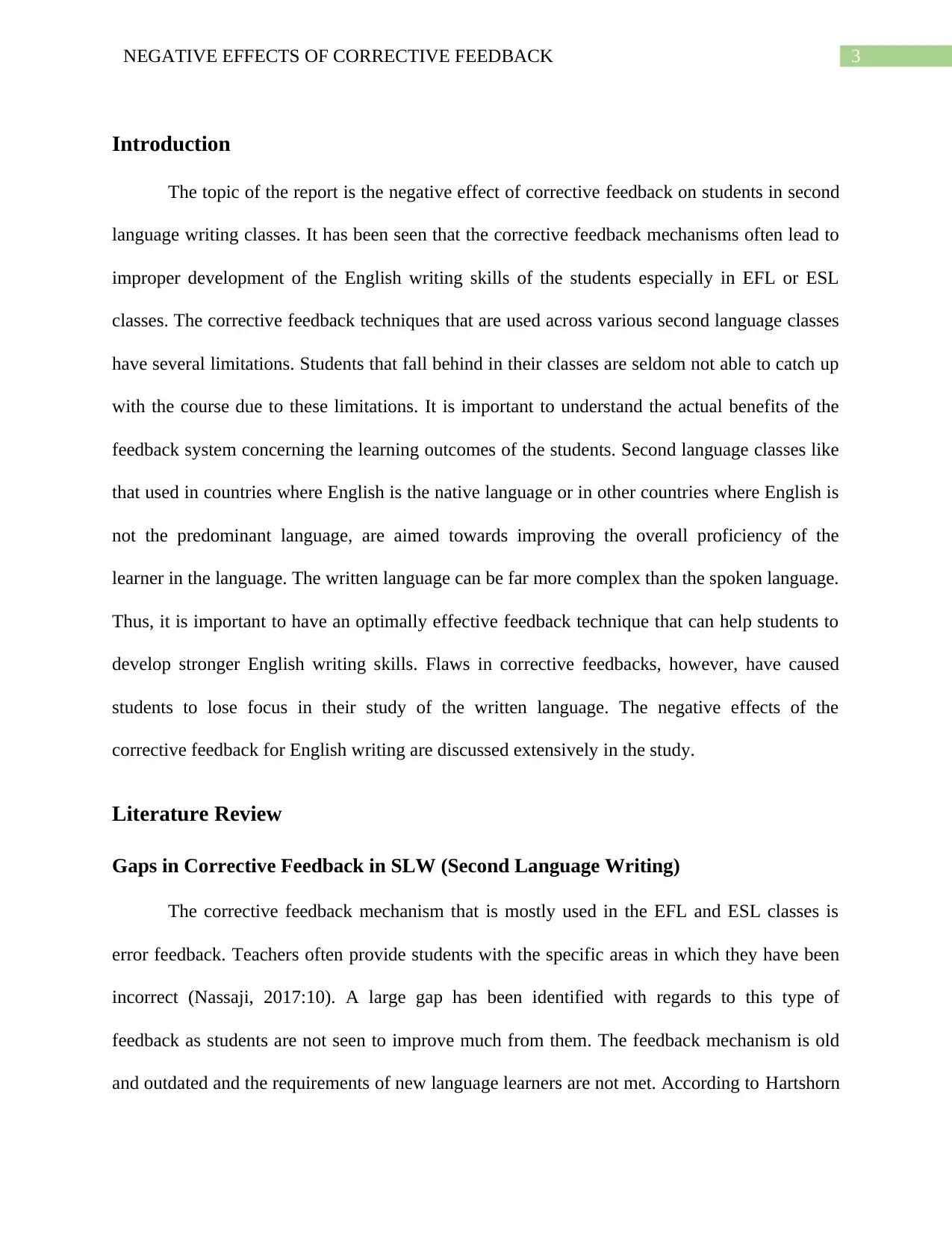
3NEGATIVE EFFECTS OF CORRECTIVE FEEDBACK
Introduction
The topic of the report is the negative effect of corrective feedback on students in second
language writing classes. It has been seen that the corrective feedback mechanisms often lead to
improper development of the English writing skills of the students especially in EFL or ESL
classes. The corrective feedback techniques that are used across various second language classes
have several limitations. Students that fall behind in their classes are seldom not able to catch up
with the course due to these limitations. It is important to understand the actual benefits of the
feedback system concerning the learning outcomes of the students. Second language classes like
that used in countries where English is the native language or in other countries where English is
not the predominant language, are aimed towards improving the overall proficiency of the
learner in the language. The written language can be far more complex than the spoken language.
Thus, it is important to have an optimally effective feedback technique that can help students to
develop stronger English writing skills. Flaws in corrective feedbacks, however, have caused
students to lose focus in their study of the written language. The negative effects of the
corrective feedback for English writing are discussed extensively in the study.
Literature Review
Gaps in Corrective Feedback in SLW (Second Language Writing)
The corrective feedback mechanism that is mostly used in the EFL and ESL classes is
error feedback. Teachers often provide students with the specific areas in which they have been
incorrect (Nassaji, 2017:10). A large gap has been identified with regards to this type of
feedback as students are not seen to improve much from them. The feedback mechanism is old
and outdated and the requirements of new language learners are not met. According to Hartshorn
Introduction
The topic of the report is the negative effect of corrective feedback on students in second
language writing classes. It has been seen that the corrective feedback mechanisms often lead to
improper development of the English writing skills of the students especially in EFL or ESL
classes. The corrective feedback techniques that are used across various second language classes
have several limitations. Students that fall behind in their classes are seldom not able to catch up
with the course due to these limitations. It is important to understand the actual benefits of the
feedback system concerning the learning outcomes of the students. Second language classes like
that used in countries where English is the native language or in other countries where English is
not the predominant language, are aimed towards improving the overall proficiency of the
learner in the language. The written language can be far more complex than the spoken language.
Thus, it is important to have an optimally effective feedback technique that can help students to
develop stronger English writing skills. Flaws in corrective feedbacks, however, have caused
students to lose focus in their study of the written language. The negative effects of the
corrective feedback for English writing are discussed extensively in the study.
Literature Review
Gaps in Corrective Feedback in SLW (Second Language Writing)
The corrective feedback mechanism that is mostly used in the EFL and ESL classes is
error feedback. Teachers often provide students with the specific areas in which they have been
incorrect (Nassaji, 2017:10). A large gap has been identified with regards to this type of
feedback as students are not seen to improve much from them. The feedback mechanism is old
and outdated and the requirements of new language learners are not met. According to Hartshorn
Paraphrase This Document
Need a fresh take? Get an instant paraphrase of this document with our AI Paraphraser
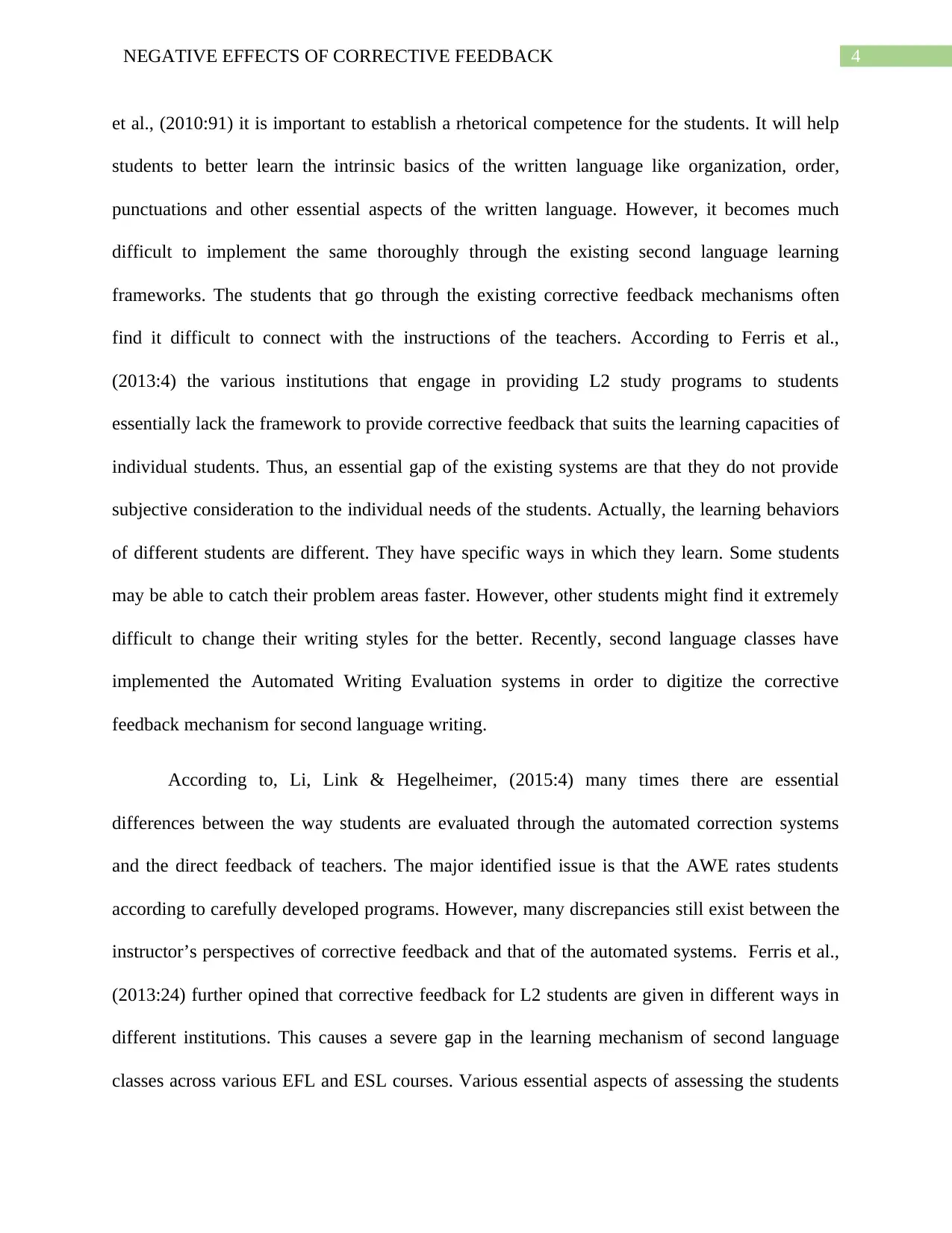
4NEGATIVE EFFECTS OF CORRECTIVE FEEDBACK
et al., (2010:91) it is important to establish a rhetorical competence for the students. It will help
students to better learn the intrinsic basics of the written language like organization, order,
punctuations and other essential aspects of the written language. However, it becomes much
difficult to implement the same thoroughly through the existing second language learning
frameworks. The students that go through the existing corrective feedback mechanisms often
find it difficult to connect with the instructions of the teachers. According to Ferris et al.,
(2013:4) the various institutions that engage in providing L2 study programs to students
essentially lack the framework to provide corrective feedback that suits the learning capacities of
individual students. Thus, an essential gap of the existing systems are that they do not provide
subjective consideration to the individual needs of the students. Actually, the learning behaviors
of different students are different. They have specific ways in which they learn. Some students
may be able to catch their problem areas faster. However, other students might find it extremely
difficult to change their writing styles for the better. Recently, second language classes have
implemented the Automated Writing Evaluation systems in order to digitize the corrective
feedback mechanism for second language writing.
According to, Li, Link & Hegelheimer, (2015:4) many times there are essential
differences between the way students are evaluated through the automated correction systems
and the direct feedback of teachers. The major identified issue is that the AWE rates students
according to carefully developed programs. However, many discrepancies still exist between the
instructor’s perspectives of corrective feedback and that of the automated systems. Ferris et al.,
(2013:24) further opined that corrective feedback for L2 students are given in different ways in
different institutions. This causes a severe gap in the learning mechanism of second language
classes across various EFL and ESL courses. Various essential aspects of assessing the students
et al., (2010:91) it is important to establish a rhetorical competence for the students. It will help
students to better learn the intrinsic basics of the written language like organization, order,
punctuations and other essential aspects of the written language. However, it becomes much
difficult to implement the same thoroughly through the existing second language learning
frameworks. The students that go through the existing corrective feedback mechanisms often
find it difficult to connect with the instructions of the teachers. According to Ferris et al.,
(2013:4) the various institutions that engage in providing L2 study programs to students
essentially lack the framework to provide corrective feedback that suits the learning capacities of
individual students. Thus, an essential gap of the existing systems are that they do not provide
subjective consideration to the individual needs of the students. Actually, the learning behaviors
of different students are different. They have specific ways in which they learn. Some students
may be able to catch their problem areas faster. However, other students might find it extremely
difficult to change their writing styles for the better. Recently, second language classes have
implemented the Automated Writing Evaluation systems in order to digitize the corrective
feedback mechanism for second language writing.
According to, Li, Link & Hegelheimer, (2015:4) many times there are essential
differences between the way students are evaluated through the automated correction systems
and the direct feedback of teachers. The major identified issue is that the AWE rates students
according to carefully developed programs. However, many discrepancies still exist between the
instructor’s perspectives of corrective feedback and that of the automated systems. Ferris et al.,
(2013:24) further opined that corrective feedback for L2 students are given in different ways in
different institutions. This causes a severe gap in the learning mechanism of second language
classes across various EFL and ESL courses. Various essential aspects of assessing the students
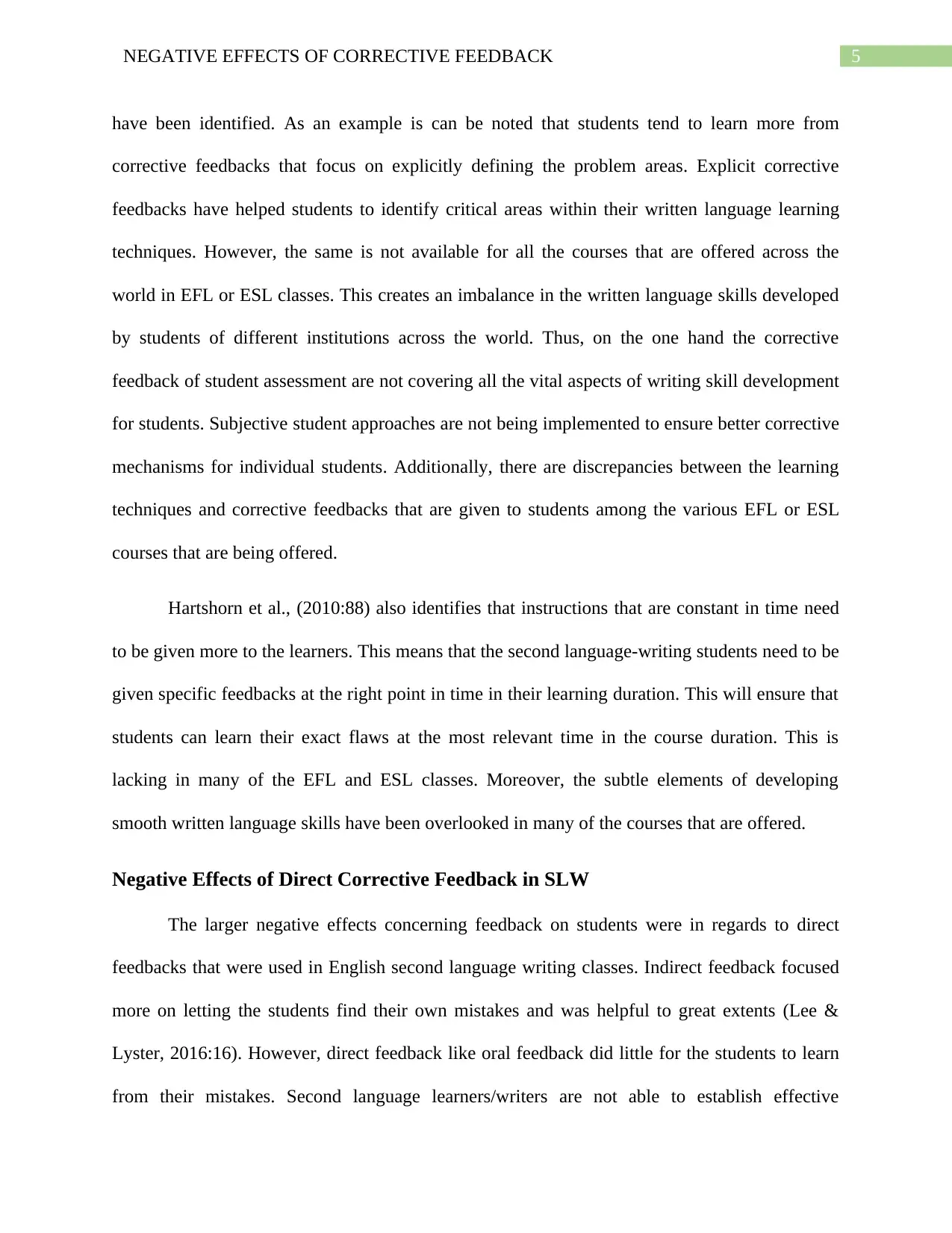
5NEGATIVE EFFECTS OF CORRECTIVE FEEDBACK
have been identified. As an example is can be noted that students tend to learn more from
corrective feedbacks that focus on explicitly defining the problem areas. Explicit corrective
feedbacks have helped students to identify critical areas within their written language learning
techniques. However, the same is not available for all the courses that are offered across the
world in EFL or ESL classes. This creates an imbalance in the written language skills developed
by students of different institutions across the world. Thus, on the one hand the corrective
feedback of student assessment are not covering all the vital aspects of writing skill development
for students. Subjective student approaches are not being implemented to ensure better corrective
mechanisms for individual students. Additionally, there are discrepancies between the learning
techniques and corrective feedbacks that are given to students among the various EFL or ESL
courses that are being offered.
Hartshorn et al., (2010:88) also identifies that instructions that are constant in time need
to be given more to the learners. This means that the second language-writing students need to be
given specific feedbacks at the right point in time in their learning duration. This will ensure that
students can learn their exact flaws at the most relevant time in the course duration. This is
lacking in many of the EFL and ESL classes. Moreover, the subtle elements of developing
smooth written language skills have been overlooked in many of the courses that are offered.
Negative Effects of Direct Corrective Feedback in SLW
The larger negative effects concerning feedback on students were in regards to direct
feedbacks that were used in English second language writing classes. Indirect feedback focused
more on letting the students find their own mistakes and was helpful to great extents (Lee &
Lyster, 2016:16). However, direct feedback like oral feedback did little for the students to learn
from their mistakes. Second language learners/writers are not able to establish effective
have been identified. As an example is can be noted that students tend to learn more from
corrective feedbacks that focus on explicitly defining the problem areas. Explicit corrective
feedbacks have helped students to identify critical areas within their written language learning
techniques. However, the same is not available for all the courses that are offered across the
world in EFL or ESL classes. This creates an imbalance in the written language skills developed
by students of different institutions across the world. Thus, on the one hand the corrective
feedback of student assessment are not covering all the vital aspects of writing skill development
for students. Subjective student approaches are not being implemented to ensure better corrective
mechanisms for individual students. Additionally, there are discrepancies between the learning
techniques and corrective feedbacks that are given to students among the various EFL or ESL
courses that are being offered.
Hartshorn et al., (2010:88) also identifies that instructions that are constant in time need
to be given more to the learners. This means that the second language-writing students need to be
given specific feedbacks at the right point in time in their learning duration. This will ensure that
students can learn their exact flaws at the most relevant time in the course duration. This is
lacking in many of the EFL and ESL classes. Moreover, the subtle elements of developing
smooth written language skills have been overlooked in many of the courses that are offered.
Negative Effects of Direct Corrective Feedback in SLW
The larger negative effects concerning feedback on students were in regards to direct
feedbacks that were used in English second language writing classes. Indirect feedback focused
more on letting the students find their own mistakes and was helpful to great extents (Lee &
Lyster, 2016:16). However, direct feedback like oral feedback did little for the students to learn
from their mistakes. Second language learners/writers are not able to establish effective
⊘ This is a preview!⊘
Do you want full access?
Subscribe today to unlock all pages.

Trusted by 1+ million students worldwide
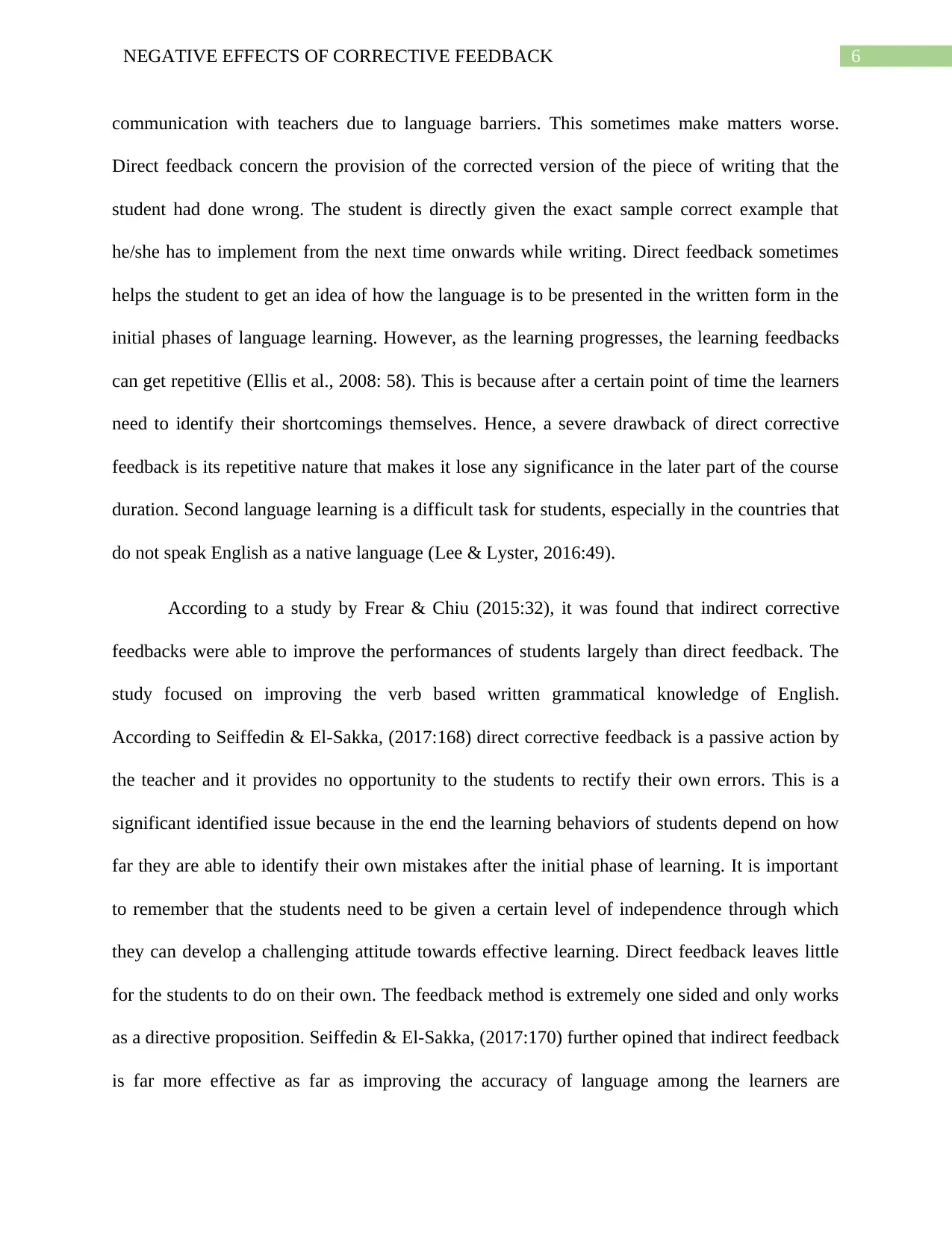
6NEGATIVE EFFECTS OF CORRECTIVE FEEDBACK
communication with teachers due to language barriers. This sometimes make matters worse.
Direct feedback concern the provision of the corrected version of the piece of writing that the
student had done wrong. The student is directly given the exact sample correct example that
he/she has to implement from the next time onwards while writing. Direct feedback sometimes
helps the student to get an idea of how the language is to be presented in the written form in the
initial phases of language learning. However, as the learning progresses, the learning feedbacks
can get repetitive (Ellis et al., 2008: 58). This is because after a certain point of time the learners
need to identify their shortcomings themselves. Hence, a severe drawback of direct corrective
feedback is its repetitive nature that makes it lose any significance in the later part of the course
duration. Second language learning is a difficult task for students, especially in the countries that
do not speak English as a native language (Lee & Lyster, 2016:49).
According to a study by Frear & Chiu (2015:32), it was found that indirect corrective
feedbacks were able to improve the performances of students largely than direct feedback. The
study focused on improving the verb based written grammatical knowledge of English.
According to Seiffedin & El-Sakka, (2017:168) direct corrective feedback is a passive action by
the teacher and it provides no opportunity to the students to rectify their own errors. This is a
significant identified issue because in the end the learning behaviors of students depend on how
far they are able to identify their own mistakes after the initial phase of learning. It is important
to remember that the students need to be given a certain level of independence through which
they can develop a challenging attitude towards effective learning. Direct feedback leaves little
for the students to do on their own. The feedback method is extremely one sided and only works
as a directive proposition. Seiffedin & El-Sakka, (2017:170) further opined that indirect feedback
is far more effective as far as improving the accuracy of language among the learners are
communication with teachers due to language barriers. This sometimes make matters worse.
Direct feedback concern the provision of the corrected version of the piece of writing that the
student had done wrong. The student is directly given the exact sample correct example that
he/she has to implement from the next time onwards while writing. Direct feedback sometimes
helps the student to get an idea of how the language is to be presented in the written form in the
initial phases of language learning. However, as the learning progresses, the learning feedbacks
can get repetitive (Ellis et al., 2008: 58). This is because after a certain point of time the learners
need to identify their shortcomings themselves. Hence, a severe drawback of direct corrective
feedback is its repetitive nature that makes it lose any significance in the later part of the course
duration. Second language learning is a difficult task for students, especially in the countries that
do not speak English as a native language (Lee & Lyster, 2016:49).
According to a study by Frear & Chiu (2015:32), it was found that indirect corrective
feedbacks were able to improve the performances of students largely than direct feedback. The
study focused on improving the verb based written grammatical knowledge of English.
According to Seiffedin & El-Sakka, (2017:168) direct corrective feedback is a passive action by
the teacher and it provides no opportunity to the students to rectify their own errors. This is a
significant identified issue because in the end the learning behaviors of students depend on how
far they are able to identify their own mistakes after the initial phase of learning. It is important
to remember that the students need to be given a certain level of independence through which
they can develop a challenging attitude towards effective learning. Direct feedback leaves little
for the students to do on their own. The feedback method is extremely one sided and only works
as a directive proposition. Seiffedin & El-Sakka, (2017:170) further opined that indirect feedback
is far more effective as far as improving the accuracy of language among the learners are
Paraphrase This Document
Need a fresh take? Get an instant paraphrase of this document with our AI Paraphraser
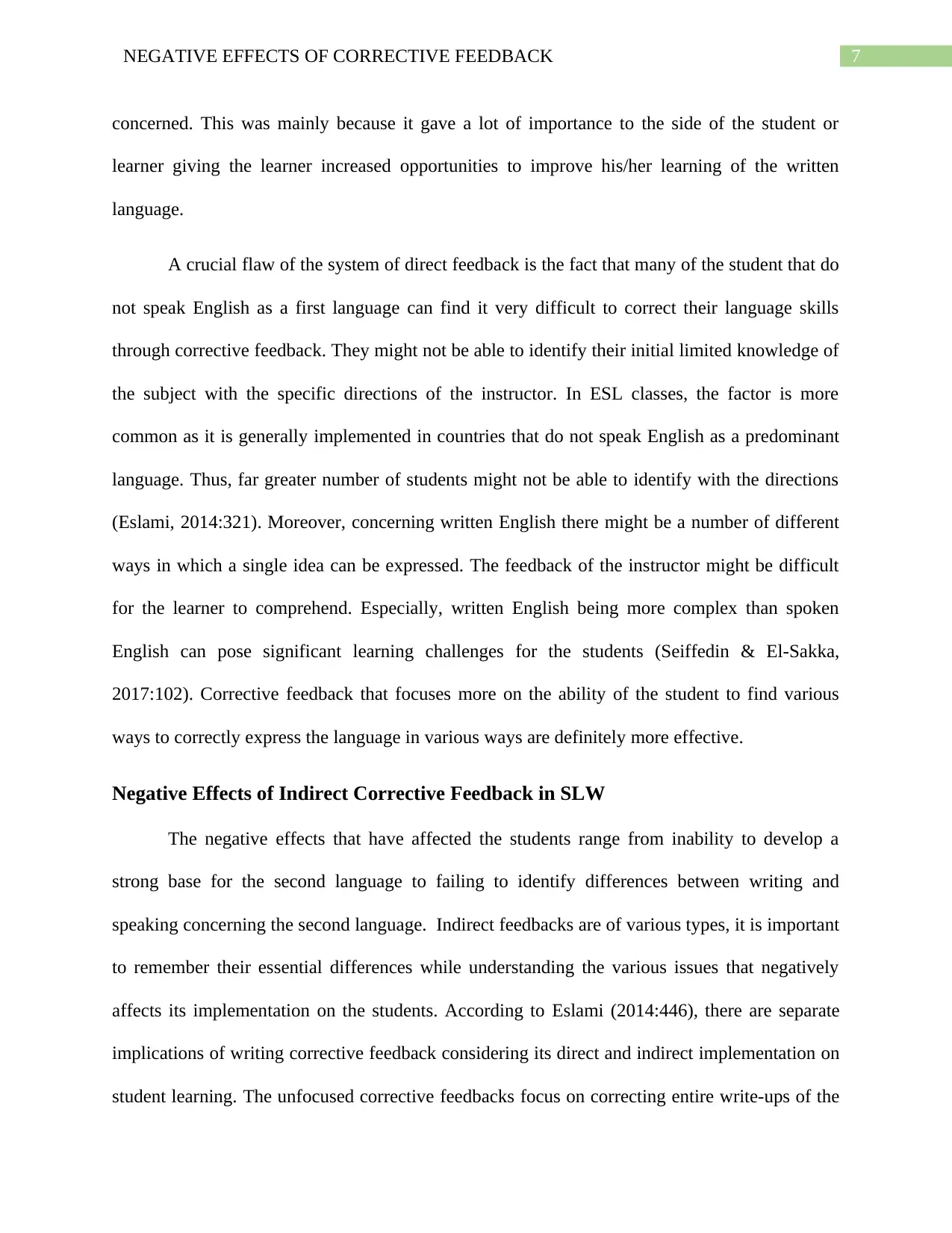
7NEGATIVE EFFECTS OF CORRECTIVE FEEDBACK
concerned. This was mainly because it gave a lot of importance to the side of the student or
learner giving the learner increased opportunities to improve his/her learning of the written
language.
A crucial flaw of the system of direct feedback is the fact that many of the student that do
not speak English as a first language can find it very difficult to correct their language skills
through corrective feedback. They might not be able to identify their initial limited knowledge of
the subject with the specific directions of the instructor. In ESL classes, the factor is more
common as it is generally implemented in countries that do not speak English as a predominant
language. Thus, far greater number of students might not be able to identify with the directions
(Eslami, 2014:321). Moreover, concerning written English there might be a number of different
ways in which a single idea can be expressed. The feedback of the instructor might be difficult
for the learner to comprehend. Especially, written English being more complex than spoken
English can pose significant learning challenges for the students (Seiffedin & El-Sakka,
2017:102). Corrective feedback that focuses more on the ability of the student to find various
ways to correctly express the language in various ways are definitely more effective.
Negative Effects of Indirect Corrective Feedback in SLW
The negative effects that have affected the students range from inability to develop a
strong base for the second language to failing to identify differences between writing and
speaking concerning the second language. Indirect feedbacks are of various types, it is important
to remember their essential differences while understanding the various issues that negatively
affects its implementation on the students. According to Eslami (2014:446), there are separate
implications of writing corrective feedback considering its direct and indirect implementation on
student learning. The unfocused corrective feedbacks focus on correcting entire write-ups of the
concerned. This was mainly because it gave a lot of importance to the side of the student or
learner giving the learner increased opportunities to improve his/her learning of the written
language.
A crucial flaw of the system of direct feedback is the fact that many of the student that do
not speak English as a first language can find it very difficult to correct their language skills
through corrective feedback. They might not be able to identify their initial limited knowledge of
the subject with the specific directions of the instructor. In ESL classes, the factor is more
common as it is generally implemented in countries that do not speak English as a predominant
language. Thus, far greater number of students might not be able to identify with the directions
(Eslami, 2014:321). Moreover, concerning written English there might be a number of different
ways in which a single idea can be expressed. The feedback of the instructor might be difficult
for the learner to comprehend. Especially, written English being more complex than spoken
English can pose significant learning challenges for the students (Seiffedin & El-Sakka,
2017:102). Corrective feedback that focuses more on the ability of the student to find various
ways to correctly express the language in various ways are definitely more effective.
Negative Effects of Indirect Corrective Feedback in SLW
The negative effects that have affected the students range from inability to develop a
strong base for the second language to failing to identify differences between writing and
speaking concerning the second language. Indirect feedbacks are of various types, it is important
to remember their essential differences while understanding the various issues that negatively
affects its implementation on the students. According to Eslami (2014:446), there are separate
implications of writing corrective feedback considering its direct and indirect implementation on
student learning. The unfocused corrective feedbacks focus on correcting entire write-ups of the
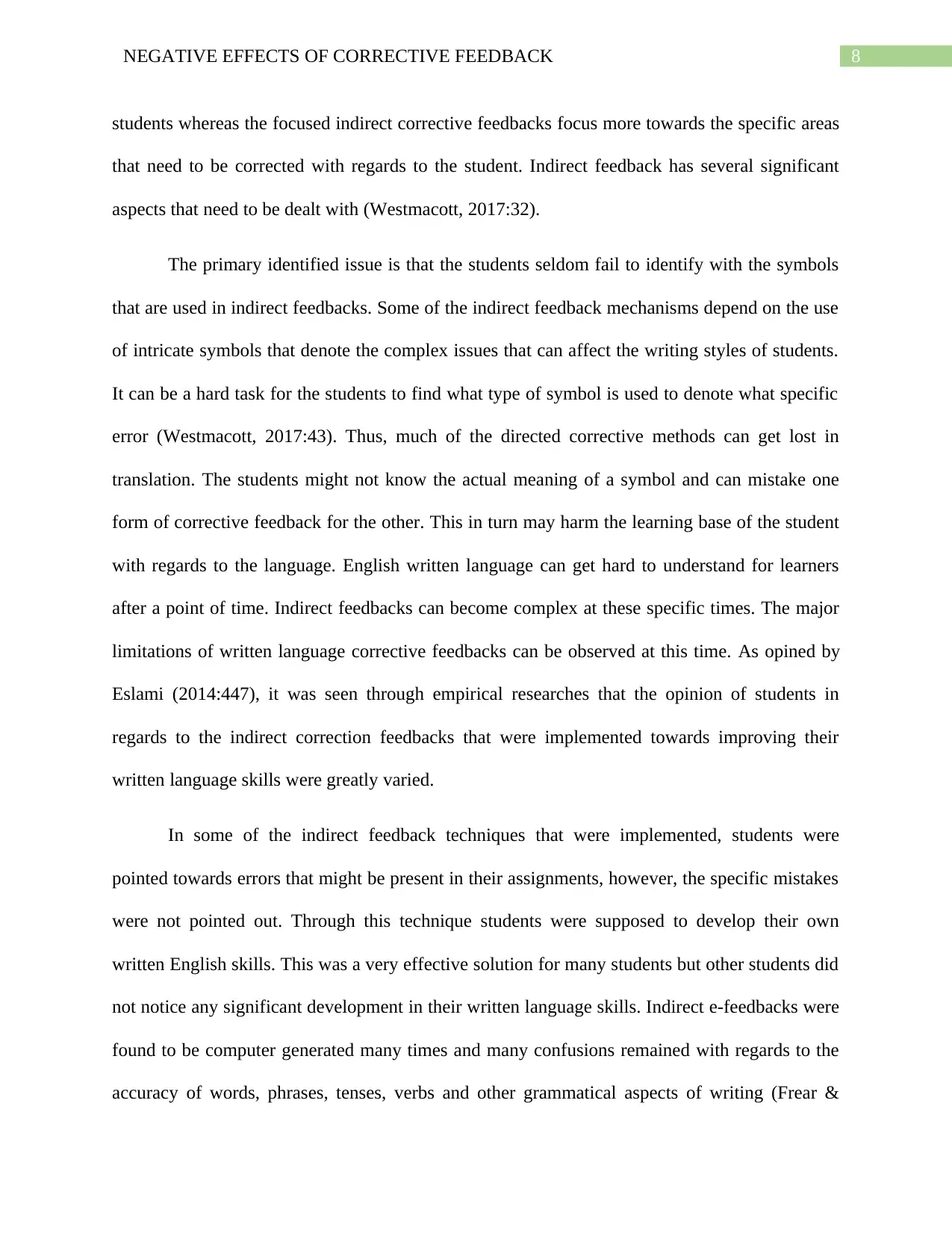
8NEGATIVE EFFECTS OF CORRECTIVE FEEDBACK
students whereas the focused indirect corrective feedbacks focus more towards the specific areas
that need to be corrected with regards to the student. Indirect feedback has several significant
aspects that need to be dealt with (Westmacott, 2017:32).
The primary identified issue is that the students seldom fail to identify with the symbols
that are used in indirect feedbacks. Some of the indirect feedback mechanisms depend on the use
of intricate symbols that denote the complex issues that can affect the writing styles of students.
It can be a hard task for the students to find what type of symbol is used to denote what specific
error (Westmacott, 2017:43). Thus, much of the directed corrective methods can get lost in
translation. The students might not know the actual meaning of a symbol and can mistake one
form of corrective feedback for the other. This in turn may harm the learning base of the student
with regards to the language. English written language can get hard to understand for learners
after a point of time. Indirect feedbacks can become complex at these specific times. The major
limitations of written language corrective feedbacks can be observed at this time. As opined by
Eslami (2014:447), it was seen through empirical researches that the opinion of students in
regards to the indirect correction feedbacks that were implemented towards improving their
written language skills were greatly varied.
In some of the indirect feedback techniques that were implemented, students were
pointed towards errors that might be present in their assignments, however, the specific mistakes
were not pointed out. Through this technique students were supposed to develop their own
written English skills. This was a very effective solution for many students but other students did
not notice any significant development in their written language skills. Indirect e-feedbacks were
found to be computer generated many times and many confusions remained with regards to the
accuracy of words, phrases, tenses, verbs and other grammatical aspects of writing (Frear &
students whereas the focused indirect corrective feedbacks focus more towards the specific areas
that need to be corrected with regards to the student. Indirect feedback has several significant
aspects that need to be dealt with (Westmacott, 2017:32).
The primary identified issue is that the students seldom fail to identify with the symbols
that are used in indirect feedbacks. Some of the indirect feedback mechanisms depend on the use
of intricate symbols that denote the complex issues that can affect the writing styles of students.
It can be a hard task for the students to find what type of symbol is used to denote what specific
error (Westmacott, 2017:43). Thus, much of the directed corrective methods can get lost in
translation. The students might not know the actual meaning of a symbol and can mistake one
form of corrective feedback for the other. This in turn may harm the learning base of the student
with regards to the language. English written language can get hard to understand for learners
after a point of time. Indirect feedbacks can become complex at these specific times. The major
limitations of written language corrective feedbacks can be observed at this time. As opined by
Eslami (2014:447), it was seen through empirical researches that the opinion of students in
regards to the indirect correction feedbacks that were implemented towards improving their
written language skills were greatly varied.
In some of the indirect feedback techniques that were implemented, students were
pointed towards errors that might be present in their assignments, however, the specific mistakes
were not pointed out. Through this technique students were supposed to develop their own
written English skills. This was a very effective solution for many students but other students did
not notice any significant development in their written language skills. Indirect e-feedbacks were
found to be computer generated many times and many confusions remained with regards to the
accuracy of words, phrases, tenses, verbs and other grammatical aspects of writing (Frear &
⊘ This is a preview!⊘
Do you want full access?
Subscribe today to unlock all pages.

Trusted by 1+ million students worldwide
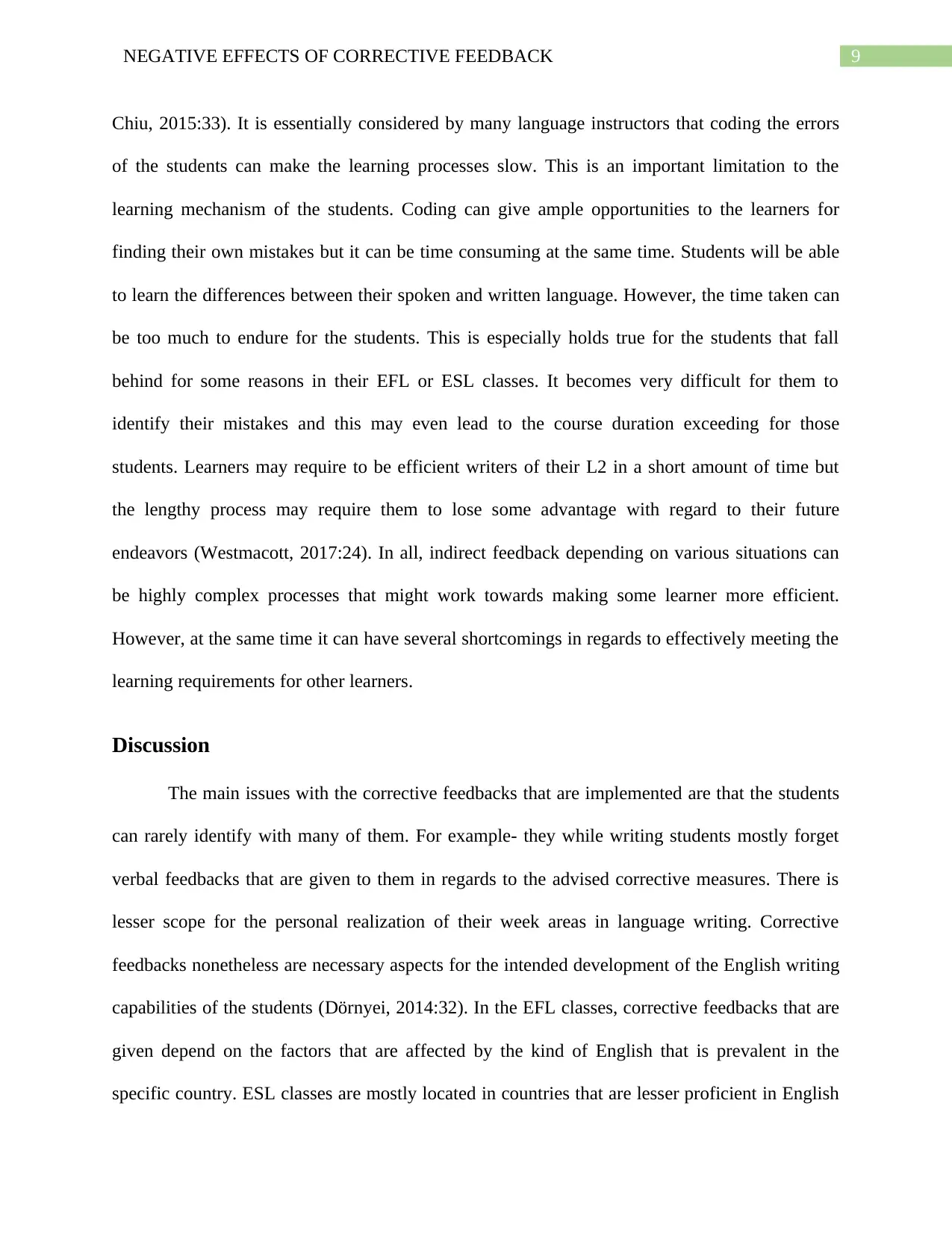
9NEGATIVE EFFECTS OF CORRECTIVE FEEDBACK
Chiu, 2015:33). It is essentially considered by many language instructors that coding the errors
of the students can make the learning processes slow. This is an important limitation to the
learning mechanism of the students. Coding can give ample opportunities to the learners for
finding their own mistakes but it can be time consuming at the same time. Students will be able
to learn the differences between their spoken and written language. However, the time taken can
be too much to endure for the students. This is especially holds true for the students that fall
behind for some reasons in their EFL or ESL classes. It becomes very difficult for them to
identify their mistakes and this may even lead to the course duration exceeding for those
students. Learners may require to be efficient writers of their L2 in a short amount of time but
the lengthy process may require them to lose some advantage with regard to their future
endeavors (Westmacott, 2017:24). In all, indirect feedback depending on various situations can
be highly complex processes that might work towards making some learner more efficient.
However, at the same time it can have several shortcomings in regards to effectively meeting the
learning requirements for other learners.
Discussion
The main issues with the corrective feedbacks that are implemented are that the students
can rarely identify with many of them. For example- they while writing students mostly forget
verbal feedbacks that are given to them in regards to the advised corrective measures. There is
lesser scope for the personal realization of their week areas in language writing. Corrective
feedbacks nonetheless are necessary aspects for the intended development of the English writing
capabilities of the students (Dörnyei, 2014:32). In the EFL classes, corrective feedbacks that are
given depend on the factors that are affected by the kind of English that is prevalent in the
specific country. ESL classes are mostly located in countries that are lesser proficient in English
Chiu, 2015:33). It is essentially considered by many language instructors that coding the errors
of the students can make the learning processes slow. This is an important limitation to the
learning mechanism of the students. Coding can give ample opportunities to the learners for
finding their own mistakes but it can be time consuming at the same time. Students will be able
to learn the differences between their spoken and written language. However, the time taken can
be too much to endure for the students. This is especially holds true for the students that fall
behind for some reasons in their EFL or ESL classes. It becomes very difficult for them to
identify their mistakes and this may even lead to the course duration exceeding for those
students. Learners may require to be efficient writers of their L2 in a short amount of time but
the lengthy process may require them to lose some advantage with regard to their future
endeavors (Westmacott, 2017:24). In all, indirect feedback depending on various situations can
be highly complex processes that might work towards making some learner more efficient.
However, at the same time it can have several shortcomings in regards to effectively meeting the
learning requirements for other learners.
Discussion
The main issues with the corrective feedbacks that are implemented are that the students
can rarely identify with many of them. For example- they while writing students mostly forget
verbal feedbacks that are given to them in regards to the advised corrective measures. There is
lesser scope for the personal realization of their week areas in language writing. Corrective
feedbacks nonetheless are necessary aspects for the intended development of the English writing
capabilities of the students (Dörnyei, 2014:32). In the EFL classes, corrective feedbacks that are
given depend on the factors that are affected by the kind of English that is prevalent in the
specific country. ESL classes are mostly located in countries that are lesser proficient in English
Paraphrase This Document
Need a fresh take? Get an instant paraphrase of this document with our AI Paraphraser
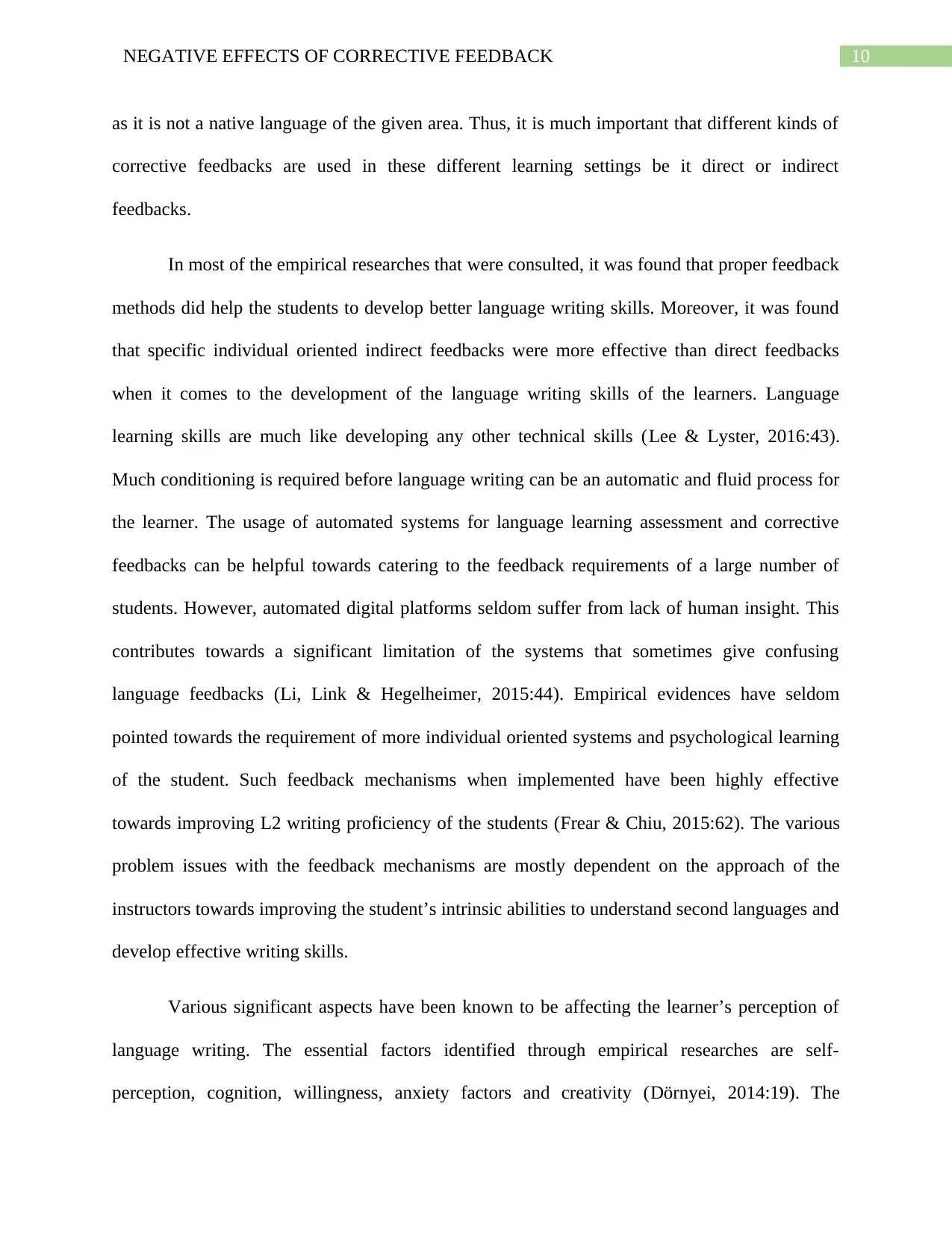
10NEGATIVE EFFECTS OF CORRECTIVE FEEDBACK
as it is not a native language of the given area. Thus, it is much important that different kinds of
corrective feedbacks are used in these different learning settings be it direct or indirect
feedbacks.
In most of the empirical researches that were consulted, it was found that proper feedback
methods did help the students to develop better language writing skills. Moreover, it was found
that specific individual oriented indirect feedbacks were more effective than direct feedbacks
when it comes to the development of the language writing skills of the learners. Language
learning skills are much like developing any other technical skills (Lee & Lyster, 2016:43).
Much conditioning is required before language writing can be an automatic and fluid process for
the learner. The usage of automated systems for language learning assessment and corrective
feedbacks can be helpful towards catering to the feedback requirements of a large number of
students. However, automated digital platforms seldom suffer from lack of human insight. This
contributes towards a significant limitation of the systems that sometimes give confusing
language feedbacks (Li, Link & Hegelheimer, 2015:44). Empirical evidences have seldom
pointed towards the requirement of more individual oriented systems and psychological learning
of the student. Such feedback mechanisms when implemented have been highly effective
towards improving L2 writing proficiency of the students (Frear & Chiu, 2015:62). The various
problem issues with the feedback mechanisms are mostly dependent on the approach of the
instructors towards improving the student’s intrinsic abilities to understand second languages and
develop effective writing skills.
Various significant aspects have been known to be affecting the learner’s perception of
language writing. The essential factors identified through empirical researches are self-
perception, cognition, willingness, anxiety factors and creativity (Dörnyei, 2014:19). The
as it is not a native language of the given area. Thus, it is much important that different kinds of
corrective feedbacks are used in these different learning settings be it direct or indirect
feedbacks.
In most of the empirical researches that were consulted, it was found that proper feedback
methods did help the students to develop better language writing skills. Moreover, it was found
that specific individual oriented indirect feedbacks were more effective than direct feedbacks
when it comes to the development of the language writing skills of the learners. Language
learning skills are much like developing any other technical skills (Lee & Lyster, 2016:43).
Much conditioning is required before language writing can be an automatic and fluid process for
the learner. The usage of automated systems for language learning assessment and corrective
feedbacks can be helpful towards catering to the feedback requirements of a large number of
students. However, automated digital platforms seldom suffer from lack of human insight. This
contributes towards a significant limitation of the systems that sometimes give confusing
language feedbacks (Li, Link & Hegelheimer, 2015:44). Empirical evidences have seldom
pointed towards the requirement of more individual oriented systems and psychological learning
of the student. Such feedback mechanisms when implemented have been highly effective
towards improving L2 writing proficiency of the students (Frear & Chiu, 2015:62). The various
problem issues with the feedback mechanisms are mostly dependent on the approach of the
instructors towards improving the student’s intrinsic abilities to understand second languages and
develop effective writing skills.
Various significant aspects have been known to be affecting the learner’s perception of
language writing. The essential factors identified through empirical researches are self-
perception, cognition, willingness, anxiety factors and creativity (Dörnyei, 2014:19). The
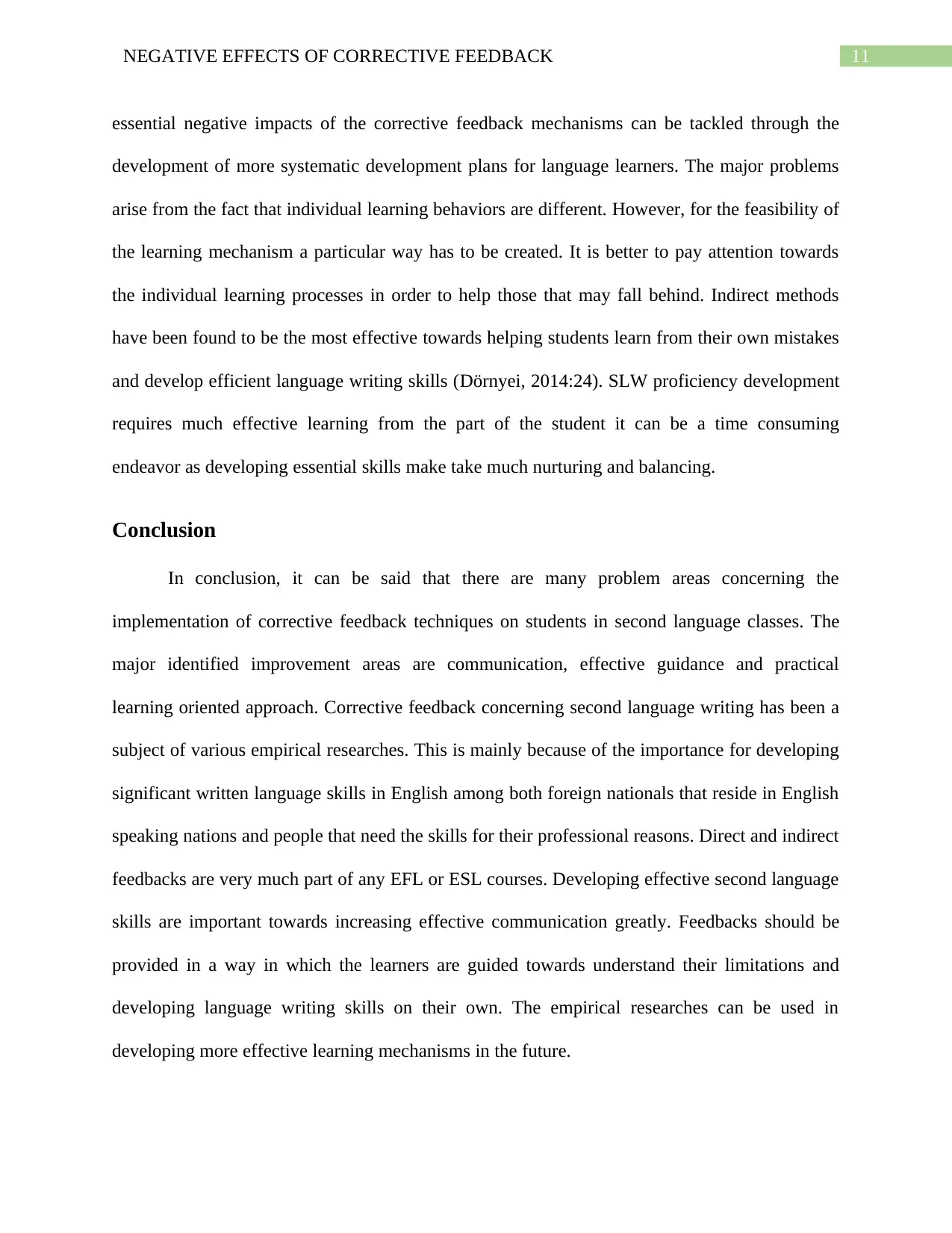
11NEGATIVE EFFECTS OF CORRECTIVE FEEDBACK
essential negative impacts of the corrective feedback mechanisms can be tackled through the
development of more systematic development plans for language learners. The major problems
arise from the fact that individual learning behaviors are different. However, for the feasibility of
the learning mechanism a particular way has to be created. It is better to pay attention towards
the individual learning processes in order to help those that may fall behind. Indirect methods
have been found to be the most effective towards helping students learn from their own mistakes
and develop efficient language writing skills (Dörnyei, 2014:24). SLW proficiency development
requires much effective learning from the part of the student it can be a time consuming
endeavor as developing essential skills make take much nurturing and balancing.
Conclusion
In conclusion, it can be said that there are many problem areas concerning the
implementation of corrective feedback techniques on students in second language classes. The
major identified improvement areas are communication, effective guidance and practical
learning oriented approach. Corrective feedback concerning second language writing has been a
subject of various empirical researches. This is mainly because of the importance for developing
significant written language skills in English among both foreign nationals that reside in English
speaking nations and people that need the skills for their professional reasons. Direct and indirect
feedbacks are very much part of any EFL or ESL courses. Developing effective second language
skills are important towards increasing effective communication greatly. Feedbacks should be
provided in a way in which the learners are guided towards understand their limitations and
developing language writing skills on their own. The empirical researches can be used in
developing more effective learning mechanisms in the future.
essential negative impacts of the corrective feedback mechanisms can be tackled through the
development of more systematic development plans for language learners. The major problems
arise from the fact that individual learning behaviors are different. However, for the feasibility of
the learning mechanism a particular way has to be created. It is better to pay attention towards
the individual learning processes in order to help those that may fall behind. Indirect methods
have been found to be the most effective towards helping students learn from their own mistakes
and develop efficient language writing skills (Dörnyei, 2014:24). SLW proficiency development
requires much effective learning from the part of the student it can be a time consuming
endeavor as developing essential skills make take much nurturing and balancing.
Conclusion
In conclusion, it can be said that there are many problem areas concerning the
implementation of corrective feedback techniques on students in second language classes. The
major identified improvement areas are communication, effective guidance and practical
learning oriented approach. Corrective feedback concerning second language writing has been a
subject of various empirical researches. This is mainly because of the importance for developing
significant written language skills in English among both foreign nationals that reside in English
speaking nations and people that need the skills for their professional reasons. Direct and indirect
feedbacks are very much part of any EFL or ESL courses. Developing effective second language
skills are important towards increasing effective communication greatly. Feedbacks should be
provided in a way in which the learners are guided towards understand their limitations and
developing language writing skills on their own. The empirical researches can be used in
developing more effective learning mechanisms in the future.
⊘ This is a preview!⊘
Do you want full access?
Subscribe today to unlock all pages.

Trusted by 1+ million students worldwide
1 out of 14
Related Documents
Your All-in-One AI-Powered Toolkit for Academic Success.
+13062052269
info@desklib.com
Available 24*7 on WhatsApp / Email
![[object Object]](/_next/static/media/star-bottom.7253800d.svg)
Unlock your academic potential
Copyright © 2020–2025 A2Z Services. All Rights Reserved. Developed and managed by ZUCOL.





